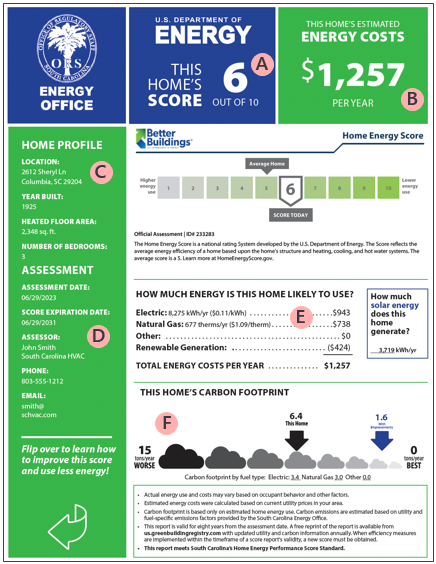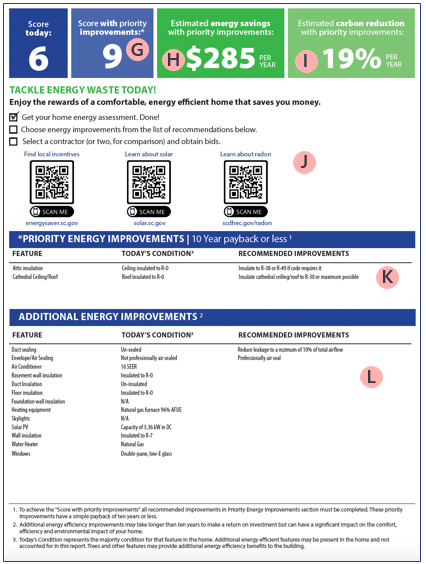Understanding the South Carolina Home Energy Label
The South Carolina Home Energy Label is designed to be a standardized report with reliable information about how a home uses energy and its estimated energy costs. Much like miles-per-gallon (MPG) ratings on vehicles or Nutrition Facts labels on food products, home energy labels help people understand how homes use energy and be informed consumers about home energy features and costs. The U.S. Department of Energy offers the Home Energy Score™ as a tool to support consistency for homeowners, buyers, and renters to understand home energy features and costs.
The images below show example South Carolina Home Energy Labels. Each report specifies metrics and home energy upgrade recommendations based on an in-home assessment completed by a qualified Home Energy Score™ Assessor. The South Carolina official home energy label features a 1-to-10 score calculated by the U.S. Department of Energy. Homes receive higher Home Energy Scores when they are estimated to have lower than average home energy costs based on data collected about each home. By contrast, homes that receive lower Home Energy Scores are estimated to have higher than average home energy costs.
Report Front Page

Report Back Page

Key
- Home Energy Score™ based on current conditions.
- Estimated annual energy cost for home.
- Basic information about the home.
- Basic information about the assessment.
- Breakdown of estimated annual energy costs by fuel type in the home.
- Representation of carbon emissions associated with the home’s energy use.
- Home Energy Score™ with all energy improvement recommendations.
- Estimated energy cost reduction with all energy improvement recommendations.
- Estimated energy use reduction with all energy improvement recommendations.
- Links to websites with more information about home energy upgrade programs.
- Energy improvements that will enable energy cost savings right away.
- Energy improvements that will be cost-effective when current equipment reaches end of life.
Frequently Asked Questions
What does a home's Score mean?
While the Home Energy Score™ provides an overall summary of the home’s energy information, the full report includes more detailed information about the energy feature data that informed the score, as well as recommended home energy upgrades and online resources for tackling energy waste. The 1-to-10 scale is set using data from U.S. Census and is adjusted for local climate conditions, allowing homes all over the country to be compared.
How does a home's size affect its Score?
Because the 1-to-10 score serves as a representation of estimated home energy costs, it does not reflect a home’s energy use or energy cost per square foot. This means that if two homes are identical other than size, the smaller home will typically receive a higher score because it has less overall volume to heat and cool.
What does a Home Energy Score of "1" mean?
Scoring a “1” does not mean a home is poorly built. A beautiful home with up-to-date equipment can still get a low score if it substantially larger than average homes or has missing insulation. A low score means a home is expected to have higher energy bills than other homes located in similar weather regions. If a home has done everything it can to improve energy efficiency, it may still reach a higher score through installing solar panels on the roof.
What does a Home Score of "10" mean?
Similarly, scoring a “10” does not mean a home cannot improve. Even a home that uses less energy than most U.S. homes may still benefit from energy upgrades that further reduce costs and pollution. Homes that score a “10” may still receive recommendations for home energy upgrades on the report.